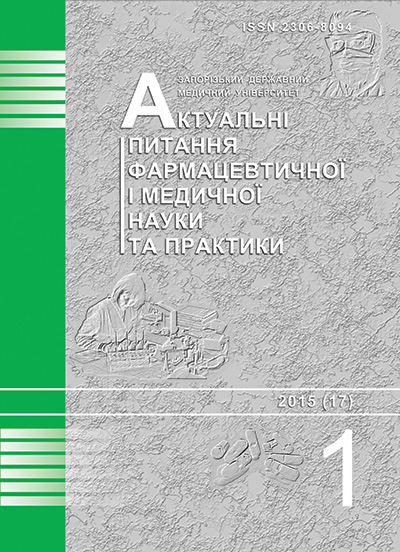Synthesis of two isomers of 3-amino-7α-12α-dihydroxy-5β-cholanic acid
DOI:
https://doi.org/10.14739/2409-2932.2015.1.41342Keywords:
Cholic Acid, Stereoisomers, 3-amino-7α-12α-dihydroxy-5β-cholanic acidAbstract
Aim.With the aim of differences investigation in physical-chemical properties optimized synthesis of the two stereoisomers of 3-amino-7-12-dihydroxycholanic acid has been performed.
Methods and results.As the source compound natural cholic acid was used. 3α-amino-7α-12α-dihydroxy-5β-cholanic acid was obtained in high yield and low number of by-products. The yield of 3β-amino-7α-12α-dihydroxy-5β-cholanic acid was low because of steric interference and process needed additional treatment stages. Column chromatography was used for cleaning compounds. The structure was studied and confirmed by NMR method. Significant differences in signals of NMR spectra and physical-chemical properties 3β-amino-7α-12α-dihydroxy-5β-cholanic acid and 3α-amino-7α-12α-dihydroxy-5β-cholanic acid wasn’t found or observed.
References
Manta, J. &Lupea, V. (1937) Resynthesis of bile acids.Bull. Soc. Chim. Biol., 19, 1343.
Chang, F.C., Wood, N.F.,&Holton, W.G. (1965) 3β,12β-Dihydroxycholanic Acid.J. Org. Chem, 30(6), 1718–1723.doi: 10.1021/jo01017a004.
Ebersole, R.C. &Chang, F.C. (1999) Improved synthesis of 12-substituted-5β-cholanes.J. Org. Chem., 38(15), 2713–2715.
Davis, A.P., Bonar-Law, R.P., Sanders, J.K.M. (1996) Receptors based on cholic acid.Comprehensive Supramolecular Chemistry, 4, 257–286.
Li, Y. &Dias, J.R. (1997) Dimeric and Oligiomeric Steroids.Chem. Rev., 97(1), 283–304.doi: 10.1021/cr9600565.
Perry, J. J.& Williams, R.P. (2009) Anion recognition by tripodal receptors.J. Am. Chem. Soc., 119, 1793–1794.
Broderick, S.,Davis, A.P.,&Williams, R.P. (1998) The«triamino-analogue» of methyl cholate; a facial amphiphile and scaffold with potential for combinatorial and molecular recognition chemistry. Tetrahedron Lett.,39, 6083–6086.doi 10.1016/S0040-4039(98)01254-4.
Moore, K.S.,Wehrli, S., Roder, H., Rogers, M.,Forrest, JN.Jr,McCrimmon, D.,&Zasloff, M. (1993) Squalamine: An Aminosterol antibiotic from the shark.Proc. Natl. Acad. Sci, 90(4), 1354–1358.doi: 10.1073/pnas.90.4.1354.
Lawless, L.J., Blackburn, A.G., Ayling, A.J., et. al. (2001) Steroidal guanidines as enantioselective receptors for N-acyl α-amino acids. P. 1. 3α-Guanylatedcarbamates derived from cholic acid.Perkin Trans 1.,11, 1329–1341.
Ding, B.,Tatofa, U., Orsak, T.,Chadwell, M.,&Savage, P. B. (2004) Synthesis and Characterization of Peptide-Cationic Steroid Antibiotic Conjugates.Org. Lett., 6(20), 3433–3436.doi: 10.1021/ol048845t.
Ryu, E.-H., Yan, J.,Zhong, Z.&Zhao,Y.(2006) Solvent-InducedAmphiphilic Molecular Baskets:Unimolecular Reversed Micelles with Different Size, Shape, and Flexibility. The Journal of Organic Chemistry, 71(19), 7205–7213. doi: 10.1021/jo0607663.
Zhao,Y., &Zhong, Z. (2005) OligomericCholates: AmphiphilicFoldamers with Nanometer-Sized Hydrophilic Cavitie. Journal of the American Chemical Society, 127(50), 17894–17901.
Downloads
How to Cite
Issue
Section
License
Authors who publish with this journal agree to the following terms:
- Authors retain copyright and grant the journal right of first publication with the work simultaneously licensed under a Creative Commons Attribution License that allows others to share the work with an acknowledgement of the work's authorship and initial publication in this journal.

- Authors are able to enter into separate, additional contractual arrangements for the non-exclusive distribution of the journal's published version of the work (e.g., post it to an institutional repository or publish it in a book), with an acknowledgement of its initial publication in this journal.
- Authors are permitted and encouraged to post their work online (e.g., in institutional repositories or on their website) prior to and during the submission process, as it can lead to productive exchanges, as well as earlier and greater citation of published work (See The Effect of Open Access)

